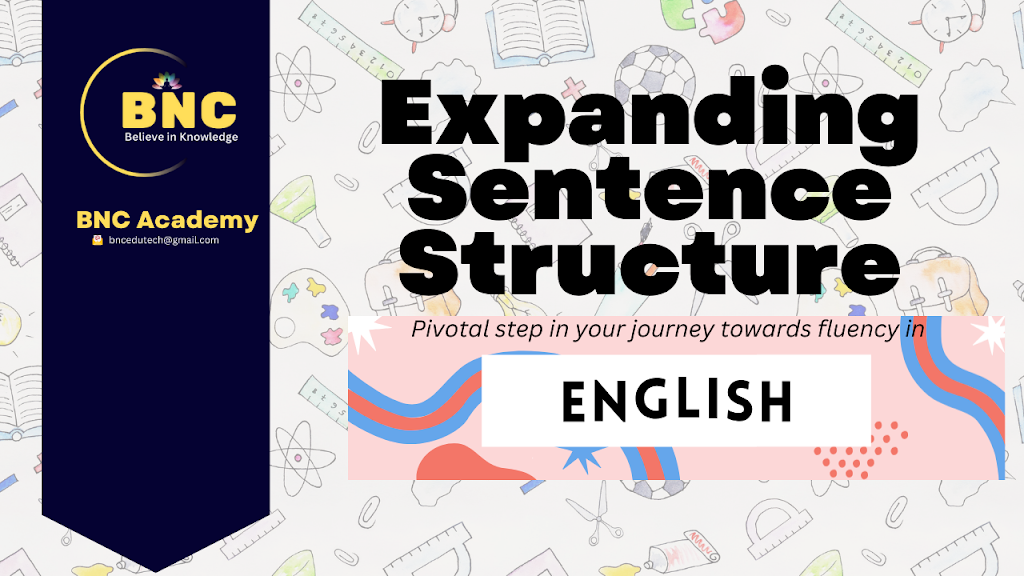
In the vast landscape of language learning, understanding the structure of sentences is akin to mastering the blueprint of communication. Whether you’re a native English speaker or a language enthusiast delving into the intricacies of English grammar, comprehending the basic structure of sentences is fundamental. One such structure that forms the backbone of English sentences is the Subject-Verb-Object (SVO) arrangement. In this blog post, we’ll embark on a journey to unravel the nuances of the SVO structure, offering insights, practice exercises, and tips to enhance your sentence construction skills.
Understanding the Basic Structure
To embark on our exploration, let’s break down the SVO structure into its constituent parts:
-
Subject:
The subject of a sentence is the entity performing the action or being described. It can be a person, place, thing, or idea. Identifying the subject is crucial as it anchors the sentence and provides context for the action.For instance:
- “The cat” in “The cat chased the mouse.”
- “Mary” in “Mary loves chocolate.”
- “The sun” in “The sun shines brightly.”
-
Verb:
The verb is the action or state of being within the sentence. It denotes what the subject is doing or the condition it’s in. Verbs can be dynamic actions, like “run,” “eat,” or “write,” or they can express a state of being, such as “is,” “am,” or “were.”For example:
- “Chased” in “The cat chased the mouse.”
- “Loves” in “Mary loves chocolate.”
- “Shines” in “The sun shines brightly.”
-
Object:
The object of a sentence is the entity that receives the action performed by the subject. It answers the question “what” or “whom” after the verb. Objects can be direct objects, indirect objects, or object complements.Consider the following:
- “The mouse” in “The cat chased the mouse.”
- “Chocolate” in “Mary loves chocolate.”
- “Brightly” in “The sun shines brightly.”
Visualizing this structure can be immensely helpful. Picture a simple sentence as a series of building blocks: the subject at the beginning, the verb in the middle, and the object at the end, forming a coherent and logical sequence of actions or descriptions.
Practice Forming Sentences
Now that we’ve grasped the basics, let’s put our knowledge into practice. Below are some guided exercises to help you form sentences using the SVO structure:
-
Exercise 1: Simple SVO Sentences
Combine the provided subjects, verbs, and objects to form simple sentences:- Subject: The dog
- Verb: sleeps
- Object: peacefully
Example Sentence: The dog sleeps peacefully.
-
Exercise 2: Expanding Sentences
Now, let’s add a bit of complexity by incorporating additional details:- Subject: Sarah
- Verb: reads
- Object: a fascinating book
Example Sentence: Sarah reads a fascinating book every evening before bed.
-
Exercise 3: Multiple Clauses
Challenge yourself by creating sentences with multiple clauses:- Subject: My brother
- Verb: cooked
- Object: a delicious meal
- Additional Clause: while listening to his favorite music
Example Sentence: My brother cooked a delicious meal while listening to his favorite music.
Remember to maintain coherence and clarity in your sentences. Each component should seamlessly connect to form a cohesive thought.
Common Errors to Avoid
While constructing sentences in the SVO structure, certain errors may arise. Let’s address some common pitfalls and how to avoid them:
-
Subject-Verb Agreement:
Ensure that the verb agrees with the subject in number (singular or plural). For instance, “The cat chases” (singular subject) vs. “The cats chase” (plural subject). -
Misplaced Modifiers:
Be wary of misplaced modifiers, which can obscure the intended meaning of a sentence. For example, “Running swiftly, the ball was caught by the player” can be ambiguous. Is the ball running swiftly, or is the player? -
Unclear Objects:
Ensure clarity in identifying the object of the sentence. Ambiguous objects can lead to confusion. For example, in the sentence “John told Mary his story,” it’s unclear whether “his story” refers to John’s or Mary’s narrative.
By being mindful of these errors, you can refine your sentence construction skills and convey your message effectively.
Expanding Sentence Structure
While the SVO structure forms the foundation of English sentences, there are variations that allow for greater flexibility and expression:
-
Subject-Verb (SV) Sentences:
In these sentences, there’s no direct object. The subject performs an action, and the sentence ends with the verb.Example: “She sings.”
-
Subject-Object (SO) Sentences:
These sentences lack a verb but feature a subject and an object. The object describes the subject without any action.Example: “The sky blue.”
-
Verb-Object (VO) Sentences:
In these sentences, the subject is implied, and the sentence consists of only the verb and the object.Example: “Eat cake.”
Exploring these variations allows for a richer understanding of sentence structure and fosters creativity in language use.
Conclusion
Mastering the Subject-Verb-Object structure is a pivotal step in your journey towards fluency in English. By understanding the roles of the subject, verb, and object, and practicing their arrangement in sentences, you can articulate your thoughts with clarity and precision. Remember to avoid common errors, experiment with different sentence structures, and most importantly, enjoy the process of linguistic exploration. Whether you’re crafting prose, engaging in conversation, or simply expressing yourself, a solid grasp of English sentence structure will serve as your steadfast companion. So, embrace the SVO structure, wield it with confidence, and let your words soar.
